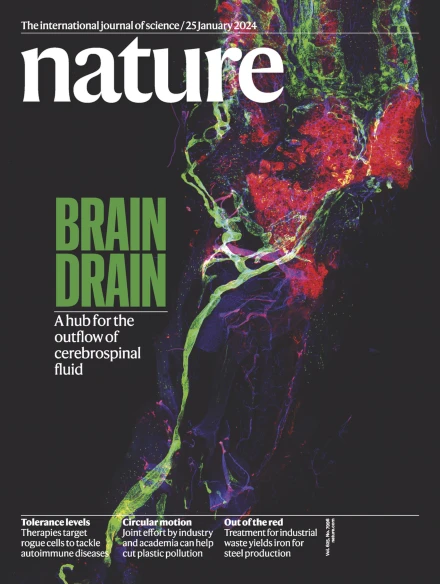Milli-spinner thrombectomy
IF 48.5
1区 综合性期刊
Q1 MULTIDISCIPLINARY SCIENCES
引用次数: 0
Abstract
Clot-induced blockage in arteries or veins can cause severe medical conditions1. Mechanical thrombectomy is a minimally invasive technique used to treat ischaemic stroke, myocardial infarction, pulmonary embolism and peripheral vascular disease2–4 by removing clots through aspiration5, stent retriever6 or cutting mechanisms7. However, current mechanical thrombectomy methods fail to remove clots in 10–30% of patients8–10, especially in the case of large, fibrin-rich clots11. These methods can also rupture and fragment clots12, causing distal emboli and poor outcomes13. To overcome these challenges, we develop the milli-spinner thrombectomy, which uses a simple yet innovative mechanics concept to modify the clot’s microstructure, facilitating its removal. The milli-spinner works by mechanically densifying the clot’s fibrin network and releasing red blood cells through spinning-induced compression and shear forces. It can shrink the clot volume by 95% for easy and fast removal. In vitro tests in pulmonary and cerebral artery flow models and in vivo experiments in swine models demonstrate that the milli-spinner achieves ultrafast clot debulking and high-fidelity revascularization, outperforming aspiration thrombectomy. The milli-spinner thrombectomy directly modifies the clot microstructure to facilitate clot removal, improving mechanical thrombectomy success rates compared with current methods that rely on clot rupture or cutting. This approach offers a promising new direction for mechanical thrombectomy devices, especially for treating ischaemic stroke, pulmonary embolism and peripheral thrombosis. The milli-spinner thrombectomy facilitates fast, complete clot removal by using spinning-induced compression and shear forces to mechanically modify the clot microstructure through densifying the fibrin network and releasing red blood cells, thus reducing clot volume.


Milli-spinner血栓切除术
血栓引起的动脉或静脉阻塞会导致严重的医疗状况。机械取栓是一种微创技术,用于治疗缺血性中风、心肌梗死、肺栓塞和周围血管疾病2,3,4,通过吸入、支架回收器或切割机制去除血栓。然而,目前的机械取栓方法在10 - 30%的患者中不能清除血栓8,9,10,特别是在大的、富含纤维蛋白的血栓的情况下11。这些方法也可能使血块破裂和破碎,导致远端栓塞和不良结果。为了克服这些挑战,我们开发了微旋血栓切除术,它使用简单而创新的力学概念来改变血栓的微观结构,促进其去除。微纺丝机的工作原理是机械地使血块的纤维蛋白网络致密化,并通过纺丝引起的压缩和剪切力释放红细胞。可使血块体积缩小95%,易于快速清除。肺和脑动脉血流模型的体外实验以及猪模型的体内实验表明,微旋流器实现了超快的血栓消融和高保真度的血运重建,优于吸入性血栓切除术。与目前依赖凝块破裂或切割的方法相比,微旋臂取栓直接改变了凝块的微观结构,促进了凝块的去除,提高了机械取栓的成功率。这种方法为机械取栓装置,特别是治疗缺血性脑卒中、肺栓塞和外周血栓形成提供了一个有希望的新方向。
本文章由计算机程序翻译,如有差异,请以英文原文为准。
求助全文
约1分钟内获得全文
求助全文
来源期刊

Nature
综合性期刊-综合性期刊
CiteScore
90.00
自引率
1.20%
发文量
3652
审稿时长
3 months
期刊介绍:
Nature is a prestigious international journal that publishes peer-reviewed research in various scientific and technological fields. The selection of articles is based on criteria such as originality, importance, interdisciplinary relevance, timeliness, accessibility, elegance, and surprising conclusions. In addition to showcasing significant scientific advances, Nature delivers rapid, authoritative, insightful news, and interpretation of current and upcoming trends impacting science, scientists, and the broader public. The journal serves a dual purpose: firstly, to promptly share noteworthy scientific advances and foster discussions among scientists, and secondly, to ensure the swift dissemination of scientific results globally, emphasizing their significance for knowledge, culture, and daily life.
 求助内容:
求助内容: 应助结果提醒方式:
应助结果提醒方式:


